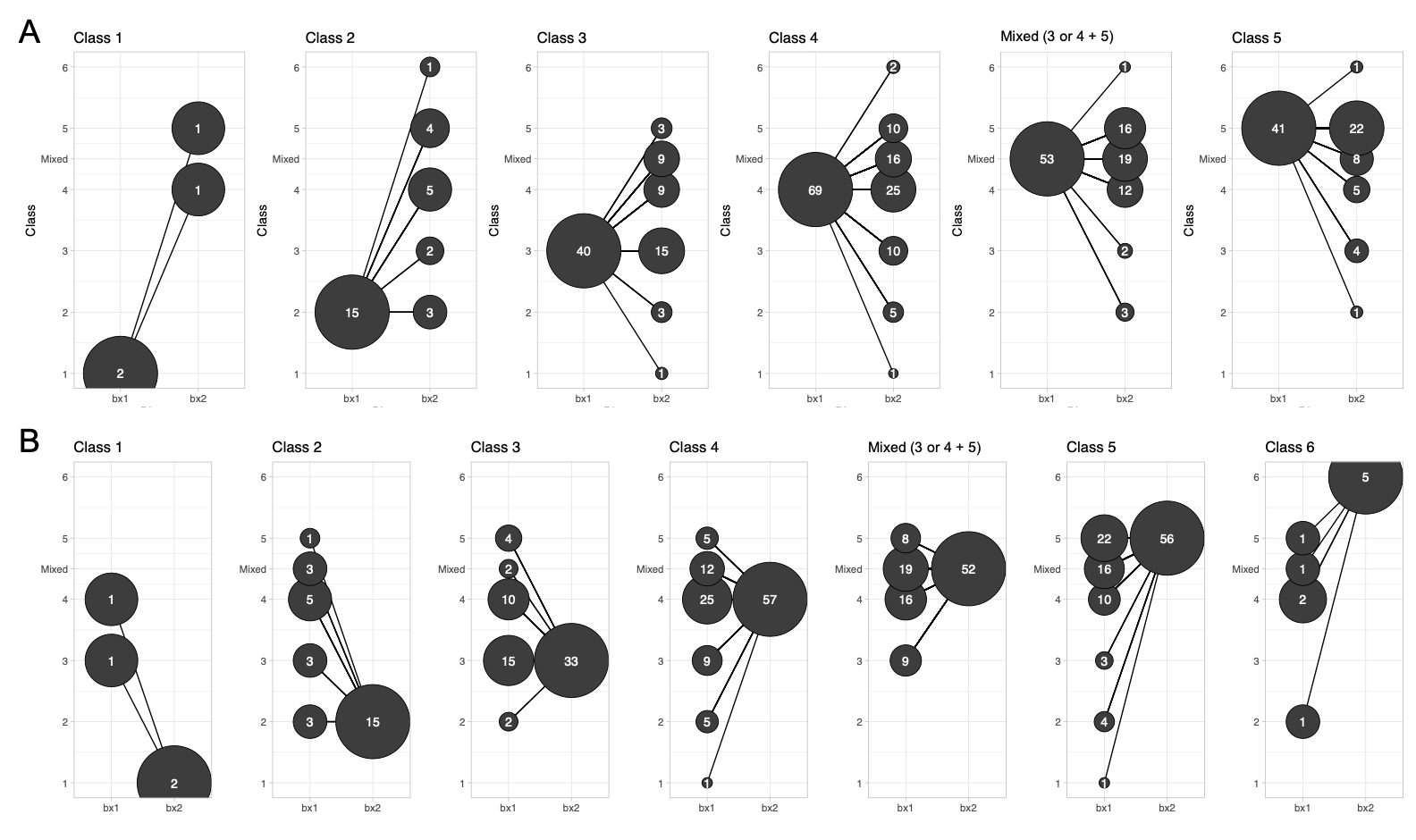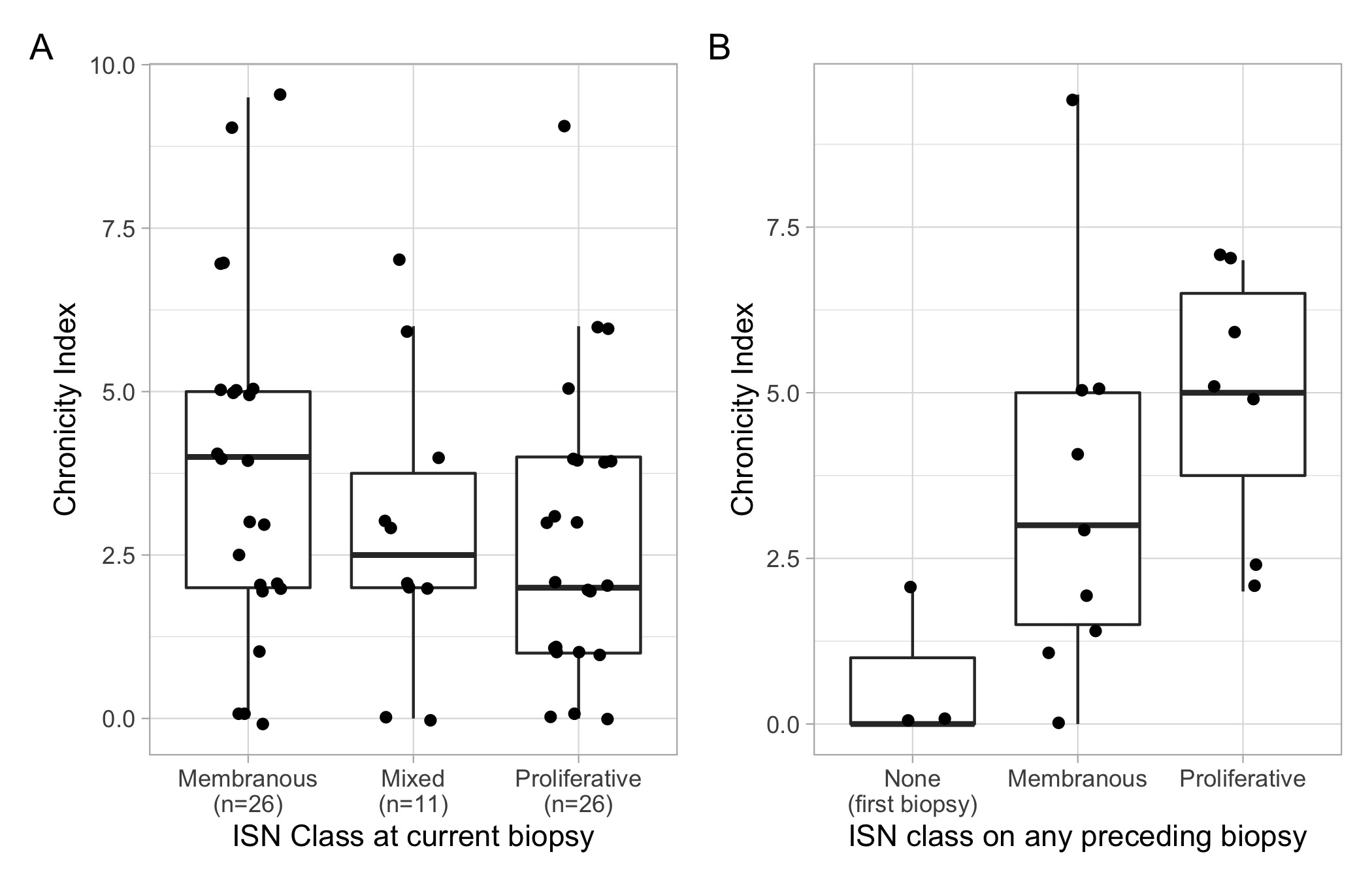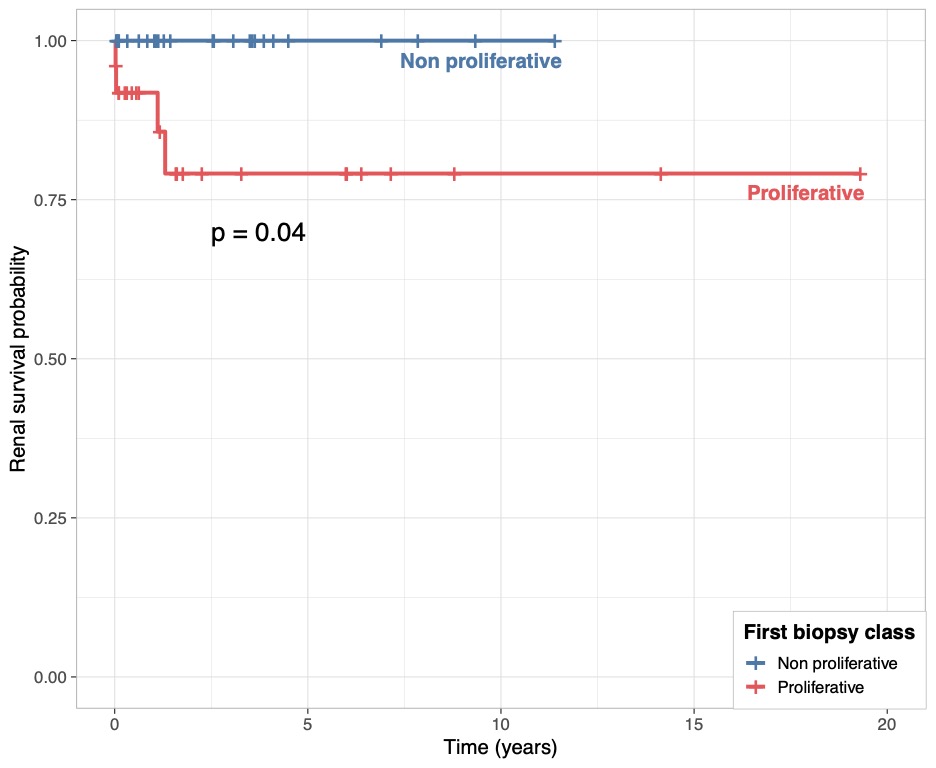Session Information
Date: Sunday, November 8, 2020
Title: SLE – Diagnosis, Manifestations, & Outcomes III: Lupus Nephritis (1512–1516)
Session Type: Abstract Session
Session Time: 4:00PM-4:50PM
Background/Purpose: . Pure membranous (class V) lupus nephritis is considered a less aggressive phenotype, but renal fibrosis and chronic kidney disease may develop. Whether this chronic damage is related to previous inflammatory changes before the biopsy date has not been adequately studied.
Methods: All patients met the revised ACR and/or SLICC SLE classification criteria. We analyzed data from 220 patients with lupus nephritis (543 biopsies) with at least two renal biopsies obtained for clinical purposes. The median time between biopsies was 4 years [IQR 2-9 years]. Patients with pure membranous lupus nephritis on the second biopsy were observed for a median of 7.5 years [IQR 4-12 years]. New onset of end stage renal disease (ESRD) was defined estimated glomerular filtration rate (eGFR) < 15 ml/min/1.73m2, initiation of dialysis, or renal transplantation. Histological chronic changes in pure class V lupus nephritis biopsies were scored by 2 nephropathologists using the NIH chronicity index and averaged when discordant.
Results: Lupus nephritis transitioned to a different class in 136/220 (62%) on repeat biopsy. Pure class V transitioned to proliferative lupus nephritis in 41.5% (Figure 1A). In patients with pure class V on the second biopsy, proliferative lupus nephritis was detected in 52% of the first biopsies (Figure 1B). Surprisingly, the NIH chronicity index did not differ between class V vs. class III and IV (p=0.5) and it was numerically higher (Figure 2A). The chronicity index in repeat biopsies was higher than in first biopsies. In particular, patients with proliferative lupus nephritis in the first biopsy who transitioned to class V had numerically worse chronicity index than those with class V in the first biopsy (5 [3.75-6.5] vs. 3 [1.5-5], p=0.13) (Figure 2B). New onset ESRD was observed in 5/52 (9.6%) patients with pure class V. All 5 patients (100%) had proliferative lupus nephritis in the first biopsy (p=0.04) (Figure 3).
Conclusion: Lupus nephritis is a dynamic disease, with the separation of membranous and proliferative an artificial division based on a kidney biopsy. Non-proliferative lupus nephritis may be preceded by proliferative disease which is associated with risk of ESRD. Chronic damage, a known negative prognostic factor, is commonly observed in pure membranous nephritis and it is associated with previous proliferative disease. The management of membranous lupus nephritis should involve immunosuppression to address the high frequency of proliferative nephritis on repeat (or preceding) biopsies to proliferative disease and quantification of chronic damage should be pursued in all classes.
 Figure 1. Transition across lupus nephritis classes in repeat renal biopsies. Change of ISN class from first (bx1) to second (bx2) biopsy according the class of the first (A) or the second biopsy (B). Numbers in the circles indicate the number of biopsies. The size of the circle indicates the proportion of biopsies within each ISN class for each plot.
Figure 1. Transition across lupus nephritis classes in repeat renal biopsies. Change of ISN class from first (bx1) to second (bx2) biopsy according the class of the first (A) or the second biopsy (B). Numbers in the circles indicate the number of biopsies. The size of the circle indicates the proportion of biopsies within each ISN class for each plot.
 Figure 2. Chronic renal damage is observed in pure class V lupus nephritis and is associated with previous episodes of proliferative disease. (A) NIH chronicity index in the nephritis cohort. There was no statistically significant difference across groups. (B) NIH chronicity index in pure class V renal biopsies according to the class of the preceding renal biopsies.
Figure 2. Chronic renal damage is observed in pure class V lupus nephritis and is associated with previous episodes of proliferative disease. (A) NIH chronicity index in the nephritis cohort. There was no statistically significant difference across groups. (B) NIH chronicity index in pure class V renal biopsies according to the class of the preceding renal biopsies.
 Figure 3. Renal survival of patients with pure class V lupus nephritis in a repeat renal biopsy according the histological class of the initial biopsy. P value was calculated using the log rank test.
Figure 3. Renal survival of patients with pure class V lupus nephritis in a repeat renal biopsy according the histological class of the initial biopsy. P value was calculated using the log rank test.
To cite this abstract in AMA style:
Fava A, Rosenberg A, Bagnasco S, Fenaroli P, Li J, Monroy-Trujillo J, Fine D, Petri M. Trajectory Analysis of Repeat Renal Biopsies Identified Previous Endocapillary Proliferation as Predictor of Damage and End Stage Renal Disease in Pure Membranous Lupus Nephritis [abstract]. Arthritis Rheumatol. 2020; 72 (suppl 10). https://acrabstracts.org/abstract/trajectory-analysis-of-repeat-renal-biopsies-identified-previous-endocapillary-proliferation-as-predictor-of-damage-and-end-stage-renal-disease-in-pure-membranous-lupus-nephritis/. Accessed .« Back to ACR Convergence 2020
ACR Meeting Abstracts - https://acrabstracts.org/abstract/trajectory-analysis-of-repeat-renal-biopsies-identified-previous-endocapillary-proliferation-as-predictor-of-damage-and-end-stage-renal-disease-in-pure-membranous-lupus-nephritis/
